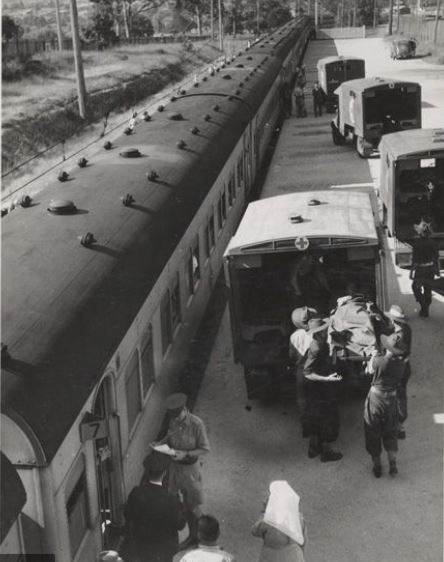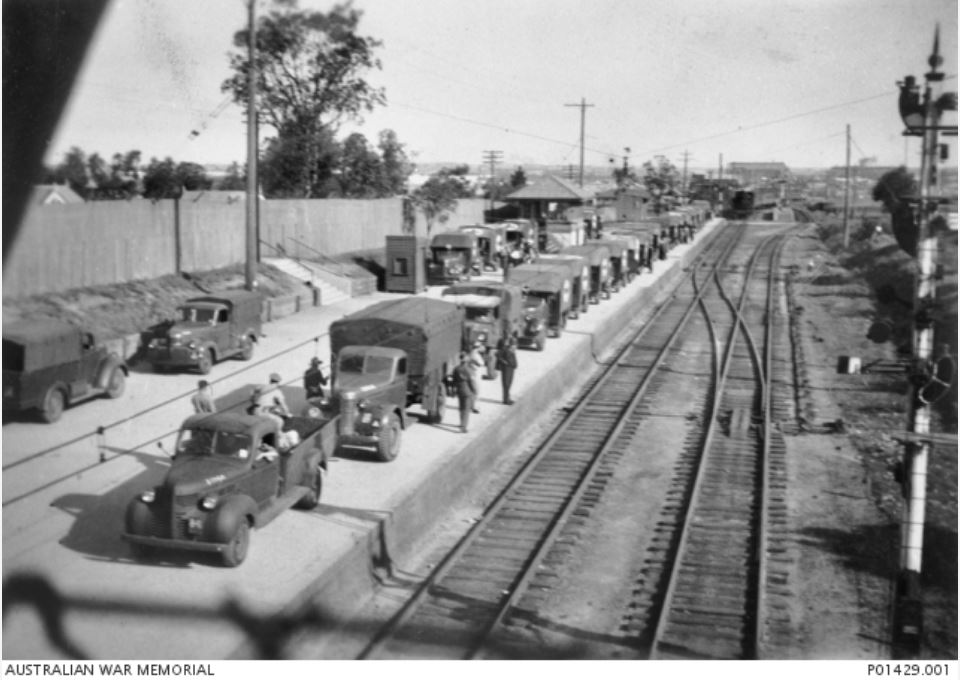Difference between revisions of "2nd Australian Ambulance Train"
From Our Contribution
(→External Links) |
(→Patients) |
||
| (4 intermediate revisions by the same user not shown) | |||
| Line 1: | Line 1: | ||
{{Infobox | {{Infobox | ||
| − | | name = Ambulance Train | + | | name = 2nd Australian Ambulance Train |
| title = | | title = | ||
| above = | | above = | ||
| subheader = | | subheader = | ||
| − | | image = [[File:]] | + | | image = [[File:2nd_Ambulance_Train.jpg]] |
| − | | caption = | + | | caption = 7 Feb 1944 Wounded being transferred into ambulances at Rosehill, NSW |
| − | | image2 = | + | | image2 = [[File:Ambulance_Train.jpg]] |
| − | | caption2 = | + | | caption2 = Sydney c1943. 2 ton Austin Ambulances of the 2nd Australian Ambulance Car Coy lined up on Rose Hill station to receive patients from train which is approaching in background. Front vehicles were command vehicle and trucks for patients personal items. AWM photo P01429.001 |
}} | }} | ||
| Line 14: | Line 14: | ||
==Brief History== | ==Brief History== | ||
| + | In June 1941 the New South Wales Government Railways converted two train sets (4'8½" gauge) for military use as hospital trains. Handed over in February 1942 hey were manned by units known as '''2nd Australian Ambulance Train''' and '''3rd Australian Ambulance Train''' which had been raised at the Sydney Showground. No 2 Ambulance Train generally worked the Sydney/Albury main line and the Sydney/Bathurst line, based at Moss Vale. When 3rd Ambulance Train was handed over to the US military, in April 1943, the 2nd Ambulance Train was required to also cover the Wallangarra (Qld)/Newcastle line and the Clapham (Qld)/Sydney line. the 3rd Ambulance Train was returned from US use in June 1944, it had been substantially upgraded so this train took over the majority of the work, leaving the 2nd Ambulance train to operate ambulance cars (motor rails) on the Wallangarra/Tamworth/Werris Creek line and small trains to Sydney. In January 1945 '''2nd Australian Ambulance Train ''' was disbanded at Werris Creek. | ||
| + | ===Patients=== | ||
| + | * † [[Jack North]] 24 Dec 1942 | ||
| + | * [[Len Malarkey]] 24 -25 Jan 1943 | ||
| + | * [[Hector Charles Wood]] 29-30 May 1944 | ||
| − | |||
| − | |||
| − | |||
====Notes==== | ====Notes==== | ||
| − | + | Content has come from ''The Unit Guide - Volume 4 - The Australian Army 1939-1945'', page 4.170 - Graham R McKenzie-Smith - Big Sky Publishing - 2018 | |
<references /> | <references /> | ||
| Line 32: | Line 34: | ||
[[Category:2nd AIF Units]] | [[Category:2nd AIF Units]] | ||
| + | [[Category:Hospitals]] | ||
Latest revision as of 16:51, 12 February 2023
Brief History
In June 1941 the New South Wales Government Railways converted two train sets (4'8½" gauge) for military use as hospital trains. Handed over in February 1942 hey were manned by units known as 2nd Australian Ambulance Train and 3rd Australian Ambulance Train which had been raised at the Sydney Showground. No 2 Ambulance Train generally worked the Sydney/Albury main line and the Sydney/Bathurst line, based at Moss Vale. When 3rd Ambulance Train was handed over to the US military, in April 1943, the 2nd Ambulance Train was required to also cover the Wallangarra (Qld)/Newcastle line and the Clapham (Qld)/Sydney line. the 3rd Ambulance Train was returned from US use in June 1944, it had been substantially upgraded so this train took over the majority of the work, leaving the 2nd Ambulance train to operate ambulance cars (motor rails) on the Wallangarra/Tamworth/Werris Creek line and small trains to Sydney. In January 1945 2nd Australian Ambulance Train was disbanded at Werris Creek.
Patients
- † Jack North 24 Dec 1942
- Len Malarkey 24 -25 Jan 1943
- Hector Charles Wood 29-30 May 1944
Notes
Content has come from The Unit Guide - Volume 4 - The Australian Army 1939-1945, page 4.170 - Graham R McKenzie-Smith - Big Sky Publishing - 2018

